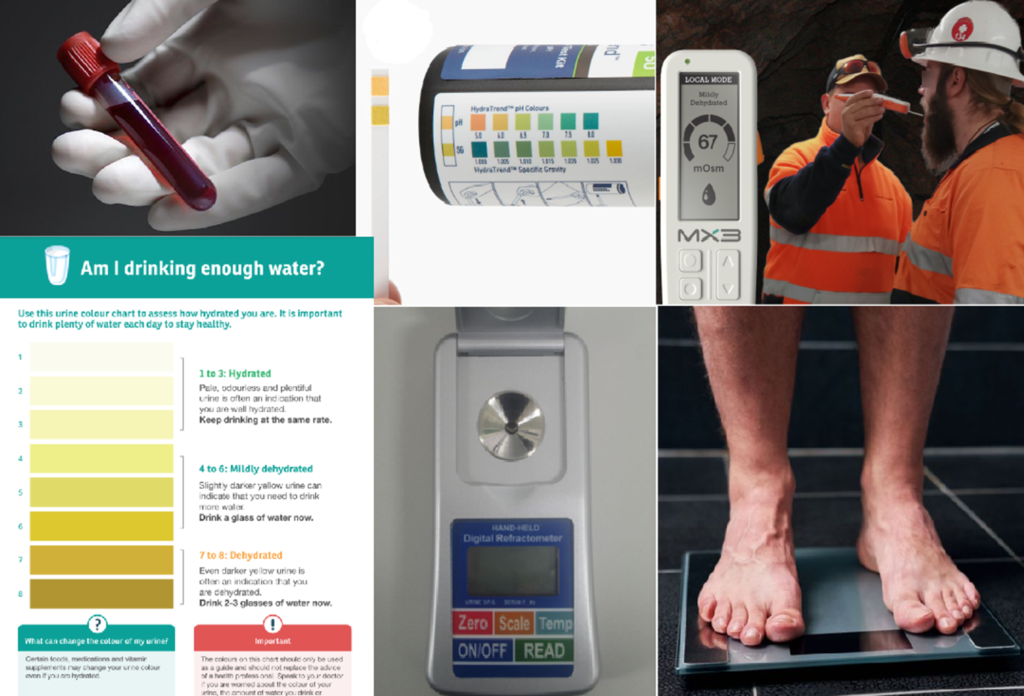Dehydration Testing in the Field.
- By Ross Di Corleto
- 15/08/2022
- No Comments

Dehydration is one of the many factors that can contribute to serious heat illnesses & hence its measurement can be a valuable tool. Despite this, its measurement still is the subject of much debate. Clinical methods such as plasma osmolality have at times been regarded as approaching the gold standard but is impractical for use in the field. There are many other forms of dehydration testing methods and equipment available. Whilst not as accurate as clinical technical methods they usually are more practical. Each has its benefits and drawbacks. This is a big topic for a one pager, but I will try.
Pre, mid, and post shift testing can provide useful information to help determine hydration status. Pre-shift is useful to assess if any pre-hydration is required. This could be because of poor fluid intake the day before or from “a big night out” and alcohol intake amongst other things. Mid-shift will identify the impact of current work scenarios and whether an adequate level of fluid intake is being maintained. Post-shift provides an overall hydration level at the end of the day and enable rehydration.
Measurement results can also be impacted by the amount and timing of fluid consumption and lead to erroneous conclusions.
Measurement Techniques in use.
Some measurement techniques may be better suited to the different approaches and scenarios, for example:
- Urine colour whilst very simple to use is not an accurate measure and is subject to interference from substances in the diet. It is however still a useful indicative tool requiring minimal equipment, training and its simplicity makes it readily used in field situations.
- A popular method in use is urine specific gravity. There is a significant amount of information available in the literature and the criteria to be used in the assessment and management of the results obtained. Its main limitation is in relation to “lag” issues so is best suited to pre-shift sampling and can be quite inaccurate for spot sampling. The method is simple and uses test strips (or a refractometer). After some preliminary training can be utilised by workers to self-test at camps or in the field.
- Saliva testing is being utilised in recent times as it is a relatively quick and non-invasive assessment method that can be used across the different approaches. However, it must be used noting the possible issues such as timing of sampling (i.e., water and food intake immediately prior) and individual variability that may be encountered. There is currently limited information available in the peer reviewed literature of its use in the field and a limitation is the requirement of access to a specific instrument, but it is also worth considering.
- Body mass change is a simple easy to use approach which requires minimal equipment (i.e., scales) is comparatively accurate and has been used for rapid assessment of acute hydration status. It does require that the individual know their normal body weight and to improve accuracy some tracking of fluid and food is useful. However, it is often seen as inconvenient and has failed to gain ready acceptance in the field.
Where there is an expected high risk of heat exposure for the shift, a proposed model would be to undertake pre-shift testing. This could be by utilising urine specific gravity or body weight and then following up with urine colour or saliva testing by the worker in conjunction with training.
Whichever approach is used it should be remembered that no matter how accurate the testing, if the information is not used to address the situation with the appropriate controls then it is of little value. Where there is uncertainty or concern relating to the status of an individual then a assessment should be undertaken by a suitably trained person at the site first aid or medical centre.
Bottom Line
No one method provides a simple and accurate method for dehydration across a shift in the field for all situations. Whilst not always practical, a combination of at two methods could be considered. It is important that whichever method/s are chosen, that the user understands the limitations of the approach/s and that the worker is educated and aware of the actions to take for any particular result.
Want to know more?
- Samuel N Cheuvront, Ely, B. R., Kenefick, R. W., Sawka, M. N., (2010) Biological variation and diagnostic accuracy of dehydration assessment markers, The American Journal of Clinical Nutrition, Volume 92, Issue 3, Pages 565–573
- Armstrong, L.E., (2007). Assessing Hydration Status: The Elusive Gold Standard. Journal of the American College of Nutrition, 26(Supplement 5), 575S–584S
- Casa. (2018). Sport and Physical Activity in the Heat. Springer International Publishing AG.
 Copyright © 2025
Copyright © 2025
Leave a Reply